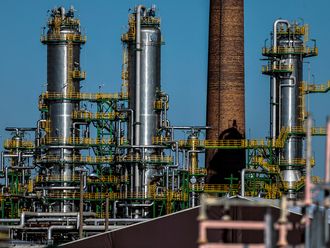Saudi Arabia’s economy is a stellar performer these days on the back of steady oil prices in recent years. The IMF projects a 3.3 per cent growth this year and rising to 4.4 per cent in the next.
On its part, Ernst & Young assumes economic growth of 4.3 and 4.6 per cent in 2013 and 2014. Clearly, all projections point out to a substantial increase in the kingdom’s GDP.
Fresh from the Haj season, the economy is reaping the positive spillover of spending made by pilgrims. Estimated in the millions of dollars, these cover travelling, accommodation and living expenses, and even the cost of animals offered as sacrifices.
The cost of sacrificed animals averages around $130 (Dh477) per pilgrim. Other expenditures deal with telecom costs and purchase of gifts by those pilgrims who are not residents of the kingdom.
Among other things, the annual Haj serves as a golden opportunity for Saudi businesses to launch new consumer products. Supply is more important than demand during Haj, as many pilgrims tend to show a tendency to buy almost anything.
In addition, the Haj season provides employment opportunities for thousands of Saudi nationals. Some Saudis, including youngsters, engage in simple trading activities such as selling foodstuff and prayer beads.
Also, a number of families have developed the habit practice of renting their places of residences during the Haj, a practice granting the chance of earning a sizable amount of extra income to help cover year-long expenses.
Moreover, other Saudis and foreign residents use their private vehicles to transport pilgrims. Undoubtedly, some activities related to Haj go unreported due to the lack of a comprehensive tax regime.
As a further testimony to the country’s economic wellbeing, numerous indexes and reports released in the recent past give high marks to Saudi economy. For instance, the Global Competitiveness Index by the World Economic Forum ranks Saudi Arabia as the 20th most competitive economy in the world.
Among Arab countries, only Qatar and the UAE outperform Saudi Arabia in the competitiveness index. But there are concerns — Saudi Arabia’s ranking is constrained by the gender factor.
In reality, the Saudi job market suffers from limited participation of Saudi women, a phenomenon that denies the economy the opportunity of attaining optimum benefits out of the country’s human resources. By one account, joblessness amongst women hovers at around 25 per cent, more than double the national average.
Another issue concerns the pressure on businesses to employ locals at the expense of expatriates. This is the very essence of the Nitaqat scheme, which went into effect in early July.
The level of local employment as stipulated in the Nitaqat scheme varies from 6 per cent for construction jobs to 30 per cent for oil and gas extraction, to over 50 per cent in banks and financial institutions.
In reality, of all the GCC countries, Saudi Arabia deserves the credit for playing a leadership role in addressing the issue of joblessness among locals, partly via regulating the job market.
On a separate note, Saudi Arabia remains the sole Arab state in the exclusive G-20 grouping, encompassing the world’s largest economies including G-8 members plus others such as China, India and Turkey. In September, the Russian city of St Petersburg hosted a summit for G-20 leaders, focusing on international economic and financial issues and amidst differences between Moscow and Washington over Syria.
Saudi Arabia’s membership reflects the qualities of being the largest economy among Arab states in addition to being the world’s largest oil exporter.












